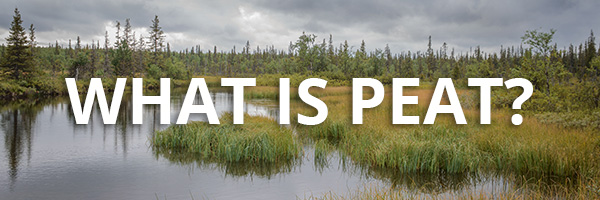
The Story of Peat Accumulation Begins with a Single Plant.
What is peat? How is peat formed? Why is peat suddenly getting a whole lot of media attention? To answer these pressing peat-focused questions, APT VP of Sales and Research, Peggy Wallgren Jones, has taken to the blogosphere.
Peat is partially decomposed plant matter that accumulates in low-lying depressions. And it’s pretty much everywhere, even if it’s not accumulating outside your doorstep. Nearly every garden center carries some sort of peat product, whether that’s peat moss or a topsoil blend or a potting mix. But what is peat really?
Consider a plant growing in a field or forest. As that plant is growing, it is “breathing” in carbon dioxide and “drinking” in minerals from the soil, ultimately converting all those elements into plant tissues such as leaves, stems and flowers. When that plant dies back, the above-ground structures generally settle into the earth and over time, those plant tissues disappear, seeming to melt into the soil. That happens because chemical reactions within the plant, hungry decomposers such as earthworms and an army of nearby microorganisms start pulling the plant apart, breaking down the complex tissue into more simple compounds. Those microorganisms are most efficient when they have an abundance of oxygen and heat, and just the right amount of moisture.
When the decomposers – the worms and insects –do their job, dead plant matter is transformed into an unrecognizable mash. That’s when bacteria and fungi break things down further, liberating carbon dioxide and returning other compounds and elements to the soil.
Now consider a similar plant growing in a lake or wetland. When that plant dies, it may fall under the water’s surface. The underwater environment has much less oxygen than an open-air system, so right off the bat, it’s a much less friendly environment for the decomposers such as worms and insects. Rather than feasting on tiny particles of plant tissue as in an upland system, the bacteria and fungi slowly nibble at the edges of large plant structures. And if that wetland plant is in a cold climate, the decomposition process goes even slower. When the next growing season rolls around, that wetland plant from the previous summer is very likely still hanging around under the water and in some cases, the plant structures may still be easily recognizable even if partially decomposed. If the plant tissues are still largely intact, most of the elements – including carbon – that went into making that plant are also intact.

If the conditions allow for repeated seasons of incomplete decomposition, those plant structures and tissues will accumulate under the water. Given enough time and growing seasons, that plant matter will compress into a material that can range from older and more highly decomposed to new and poorly decomposed fibers that are similar to the parent plant tissue. The heterogeneous material that builds over time is, at long last, peat.
Peat is obviously a product of its environment. A plant that would decompose within months in an upland environment can persist for hundreds or thousands of years in a peat-forming, waterlogged system. And there’s so much potential stored in the world’s peatlands. When harvested strategically and responsibly by companies like APT, peat has the power to positively impact our everyday lives.
As we look toward feeding an ever-increasing population, peat products can help provide food crops with the necessary nutrients more effectively, resulting in stronger yields that can feed more people. Likewise, as clean water becomes increasingly essential, peat products can be used to treat contaminated water naturally. While the majority of the world’s peatlands remain untouched carbon sinks, dedicating a small portion to next-generation peat products will benefit us all.






